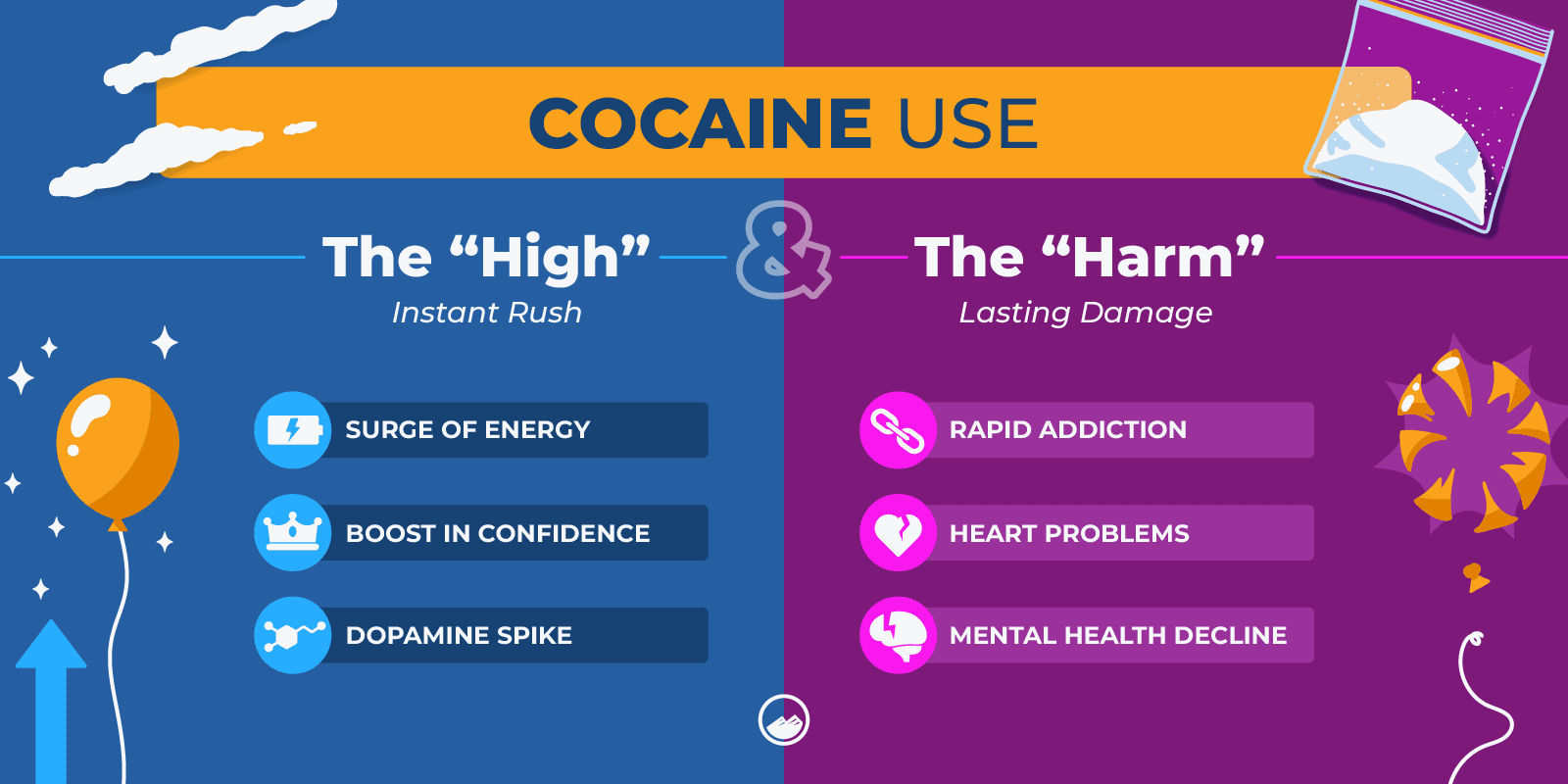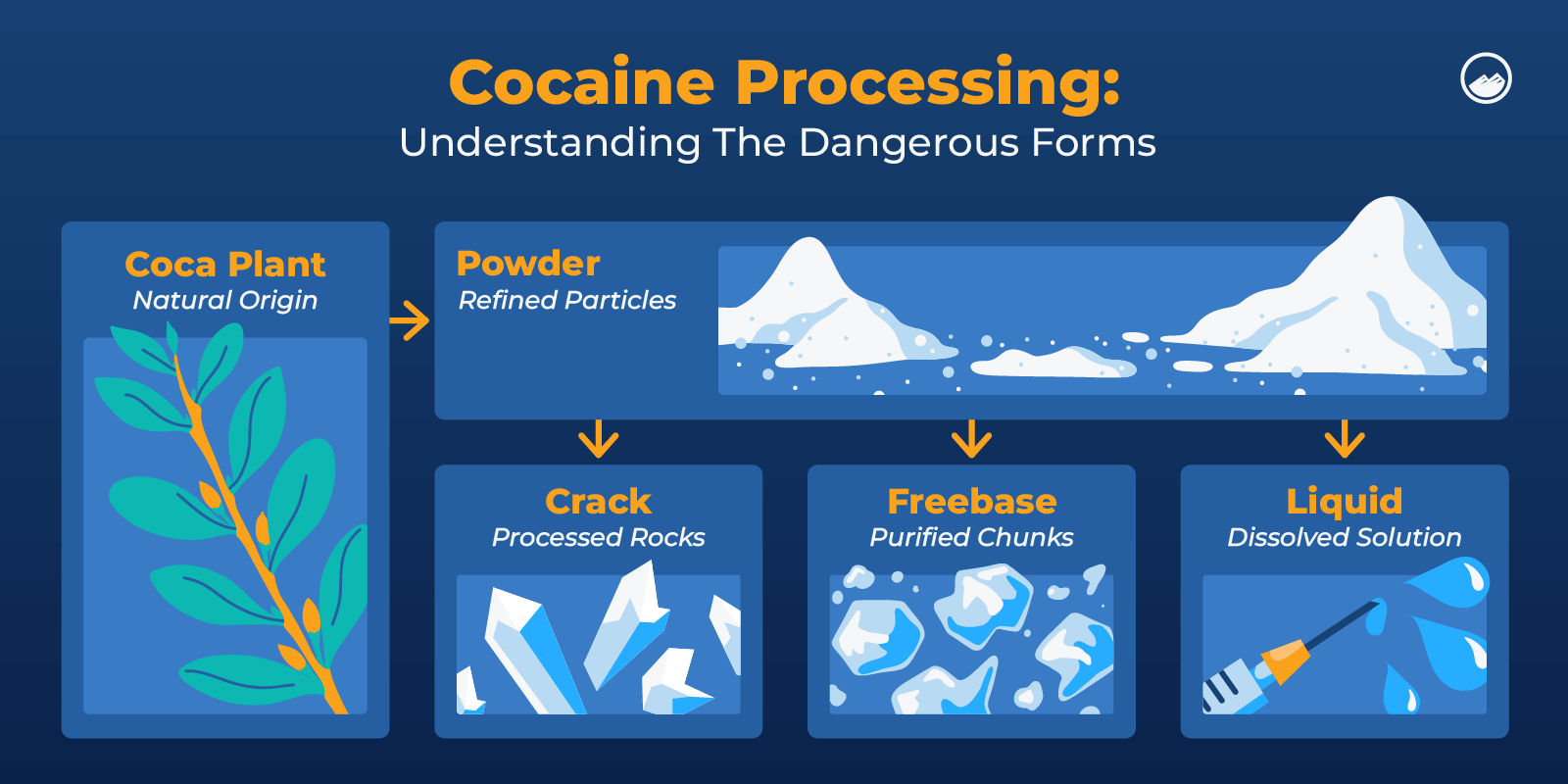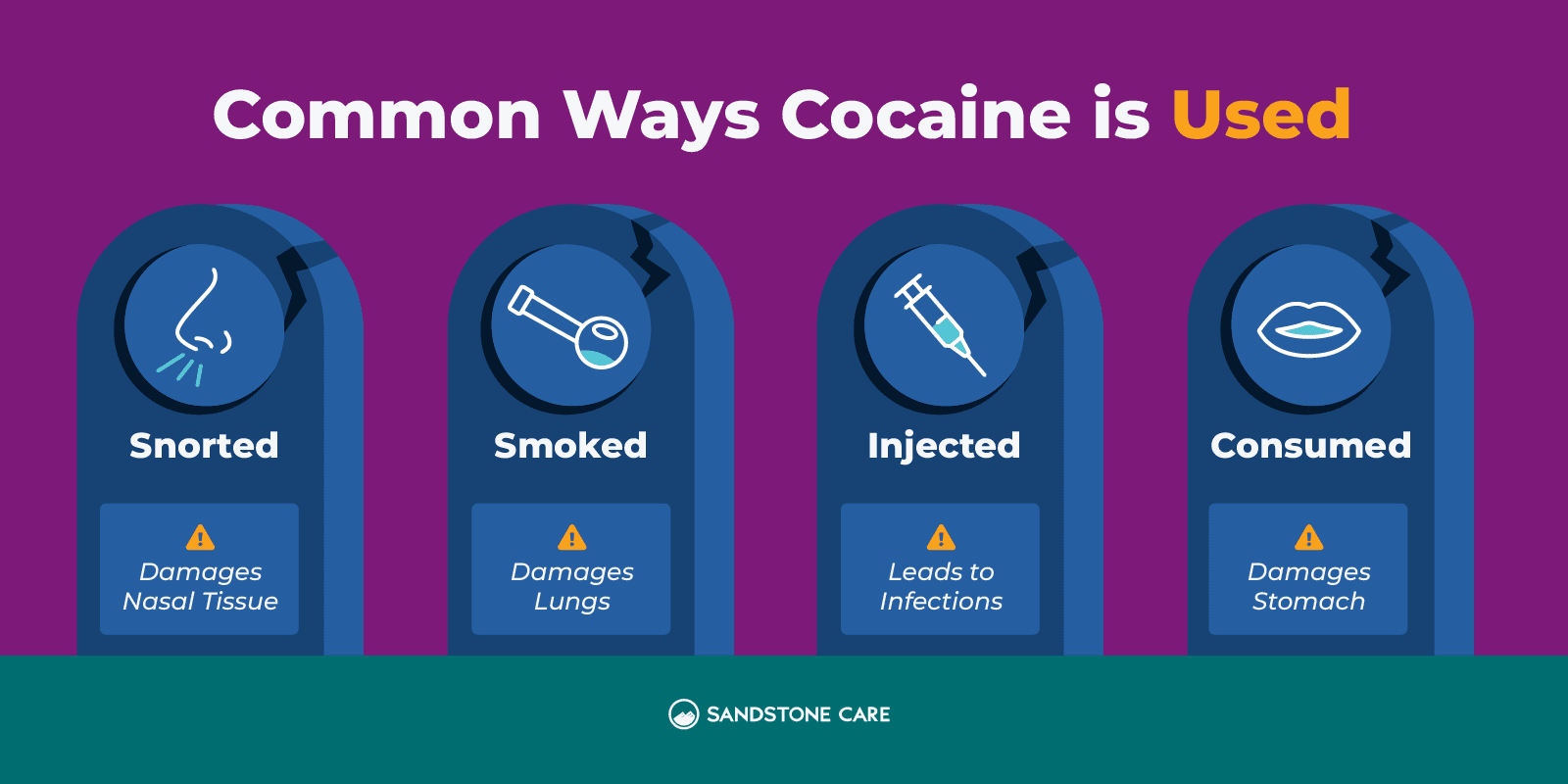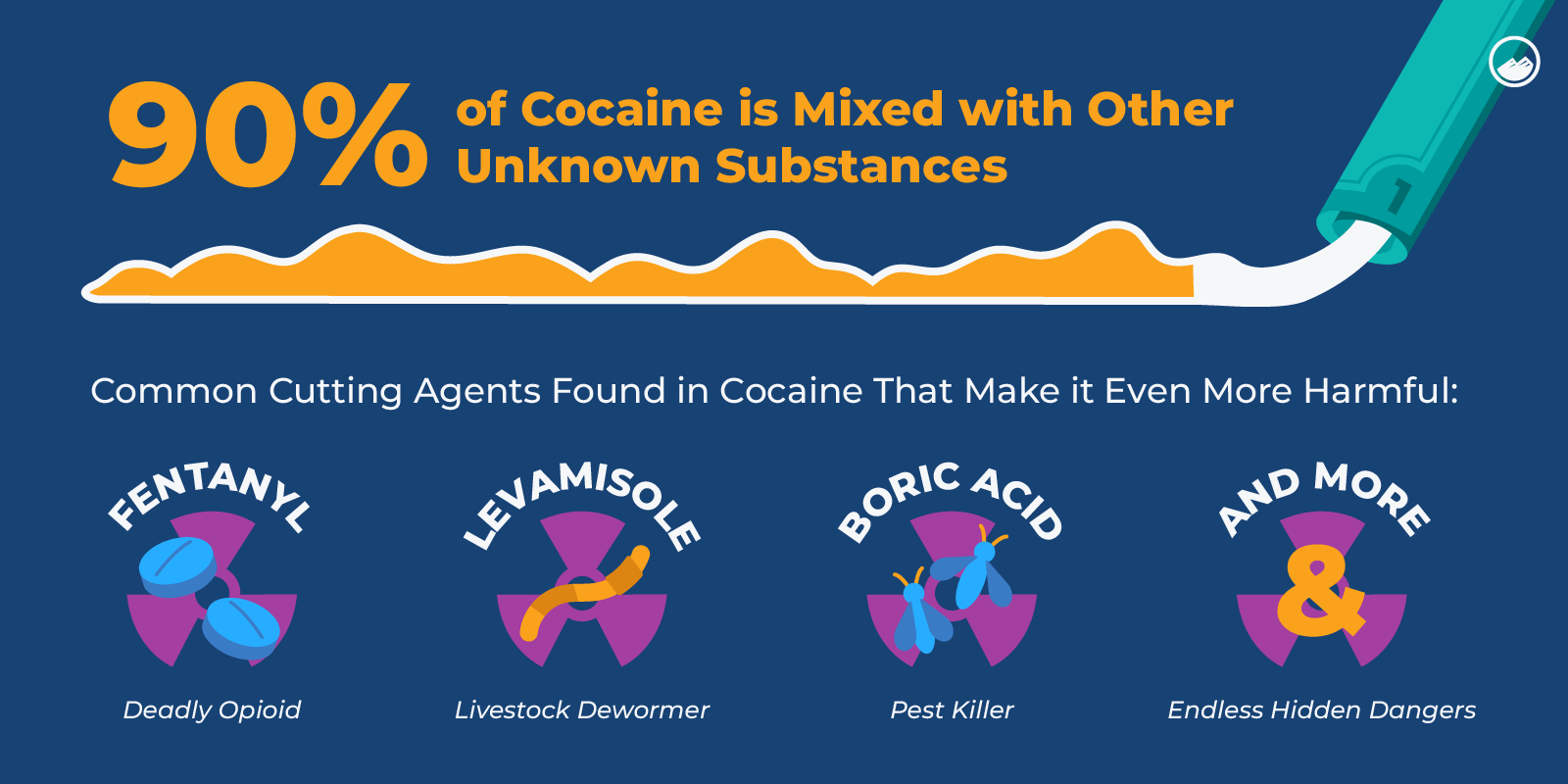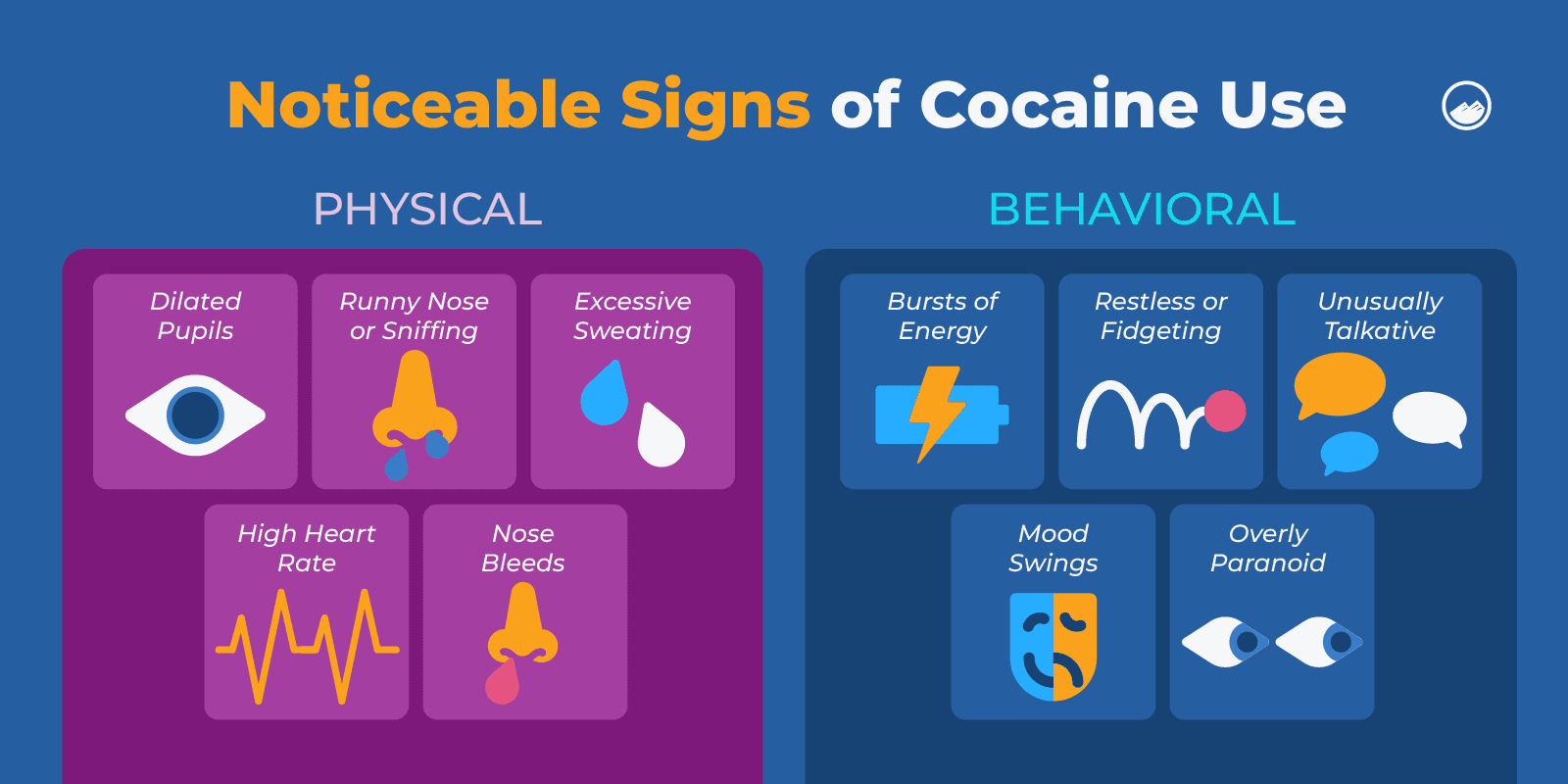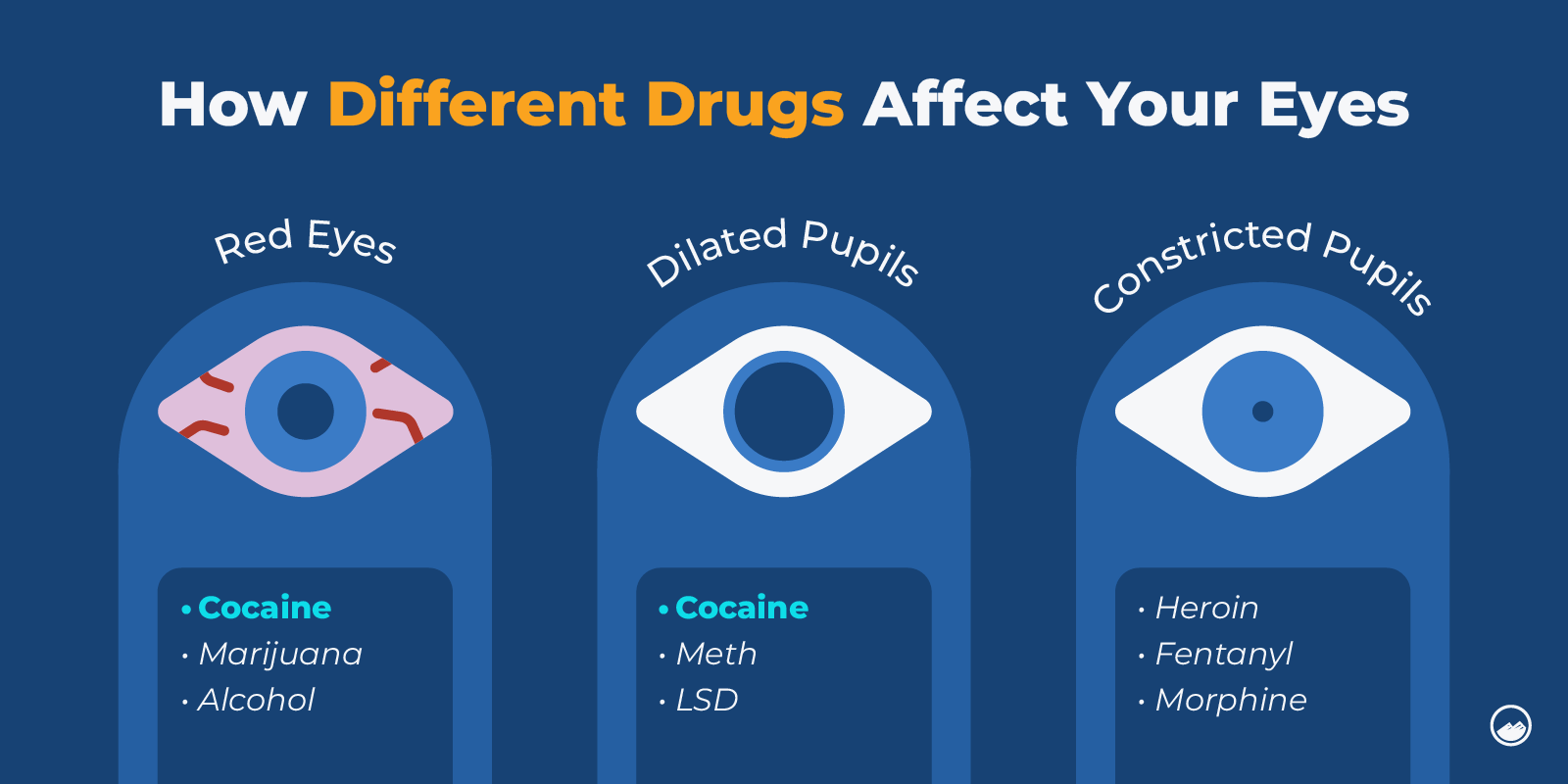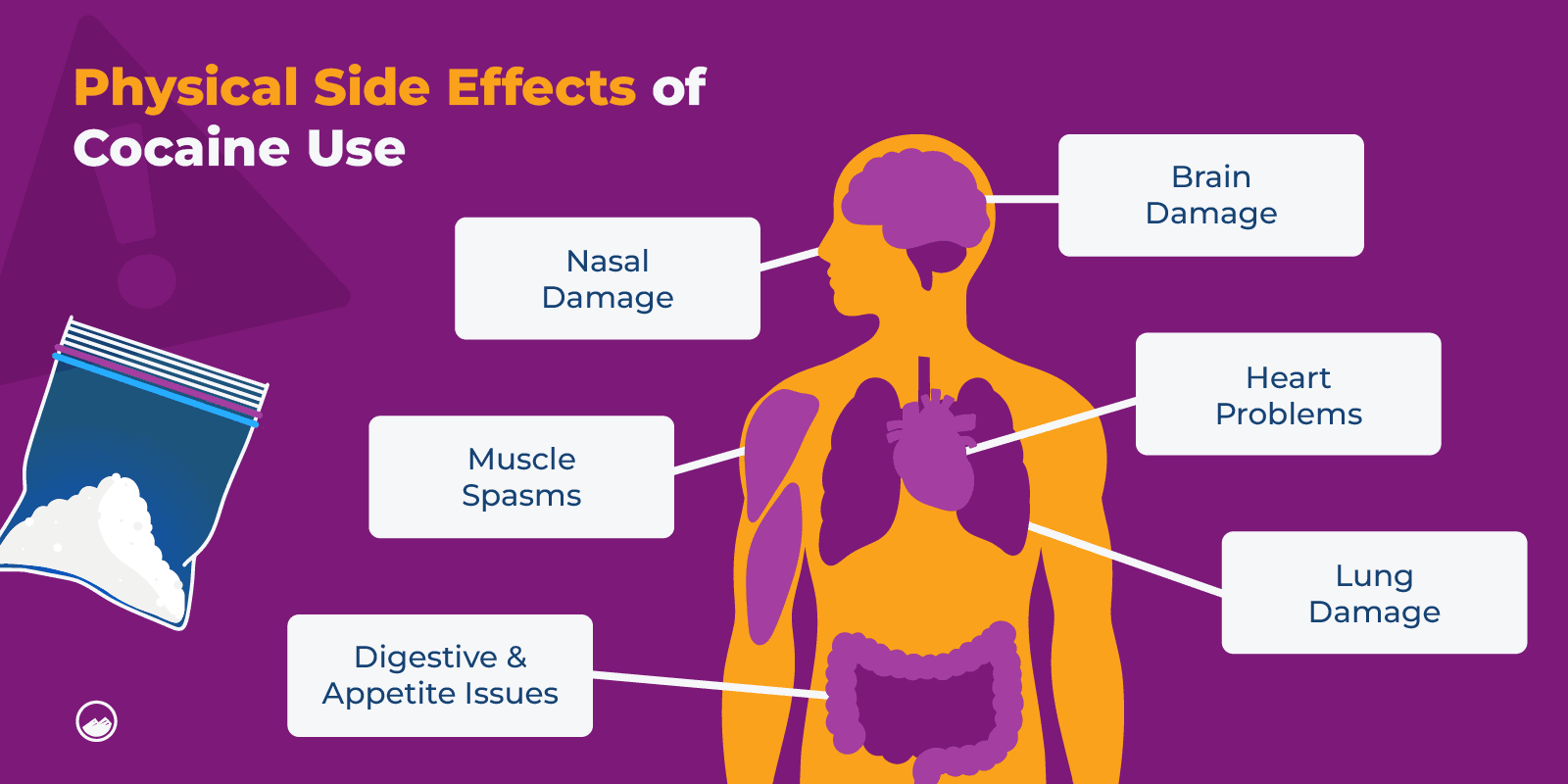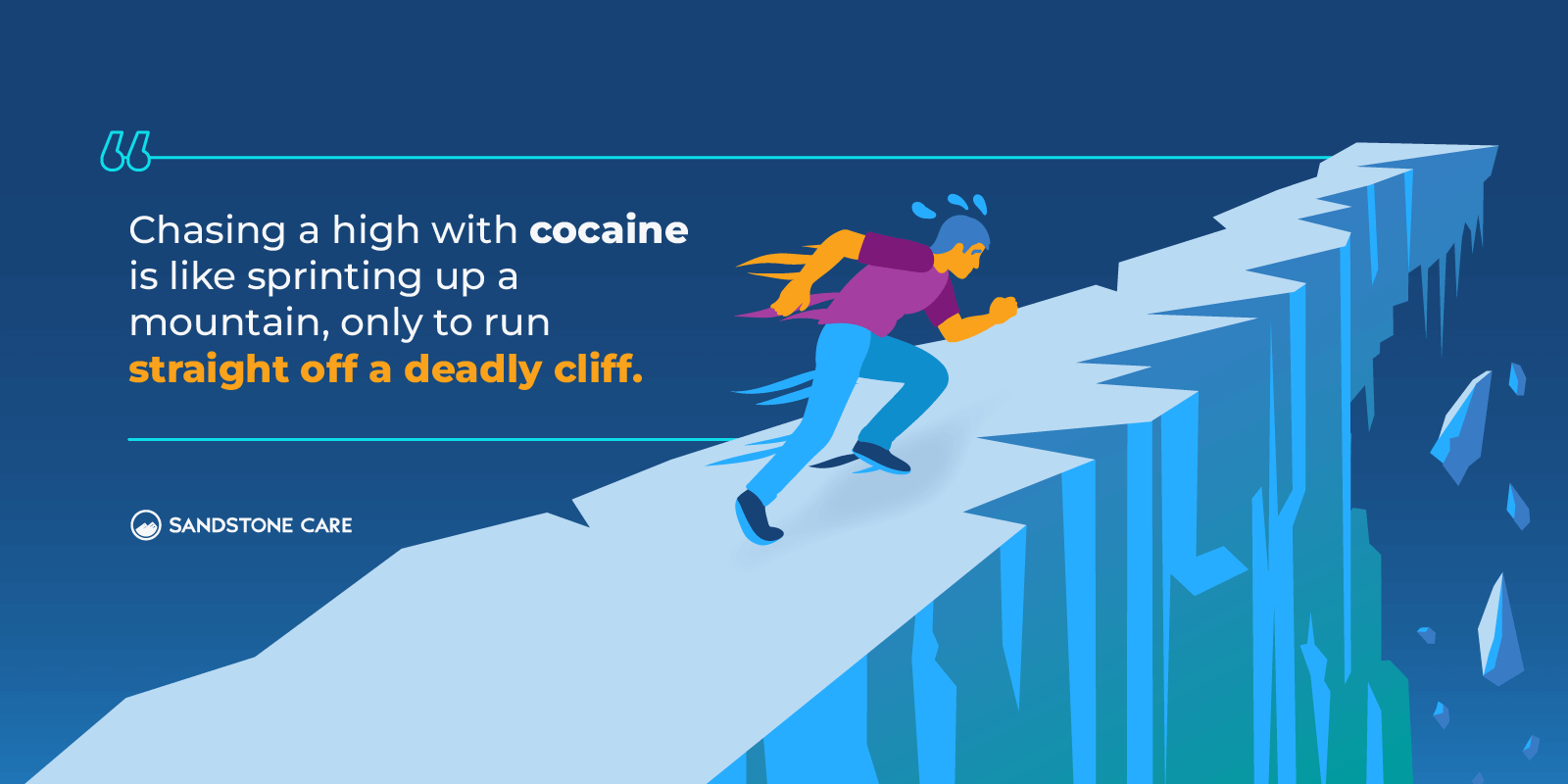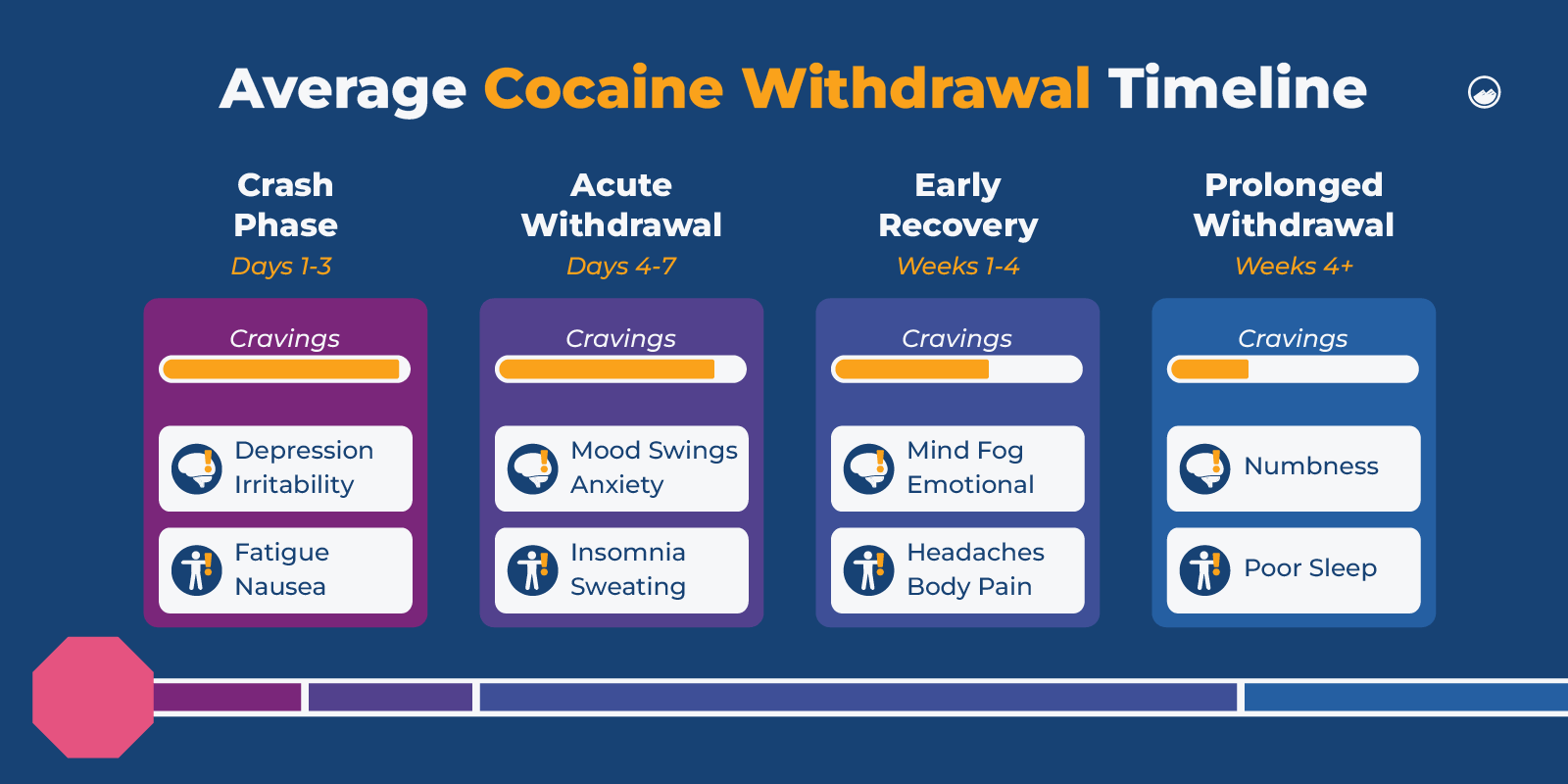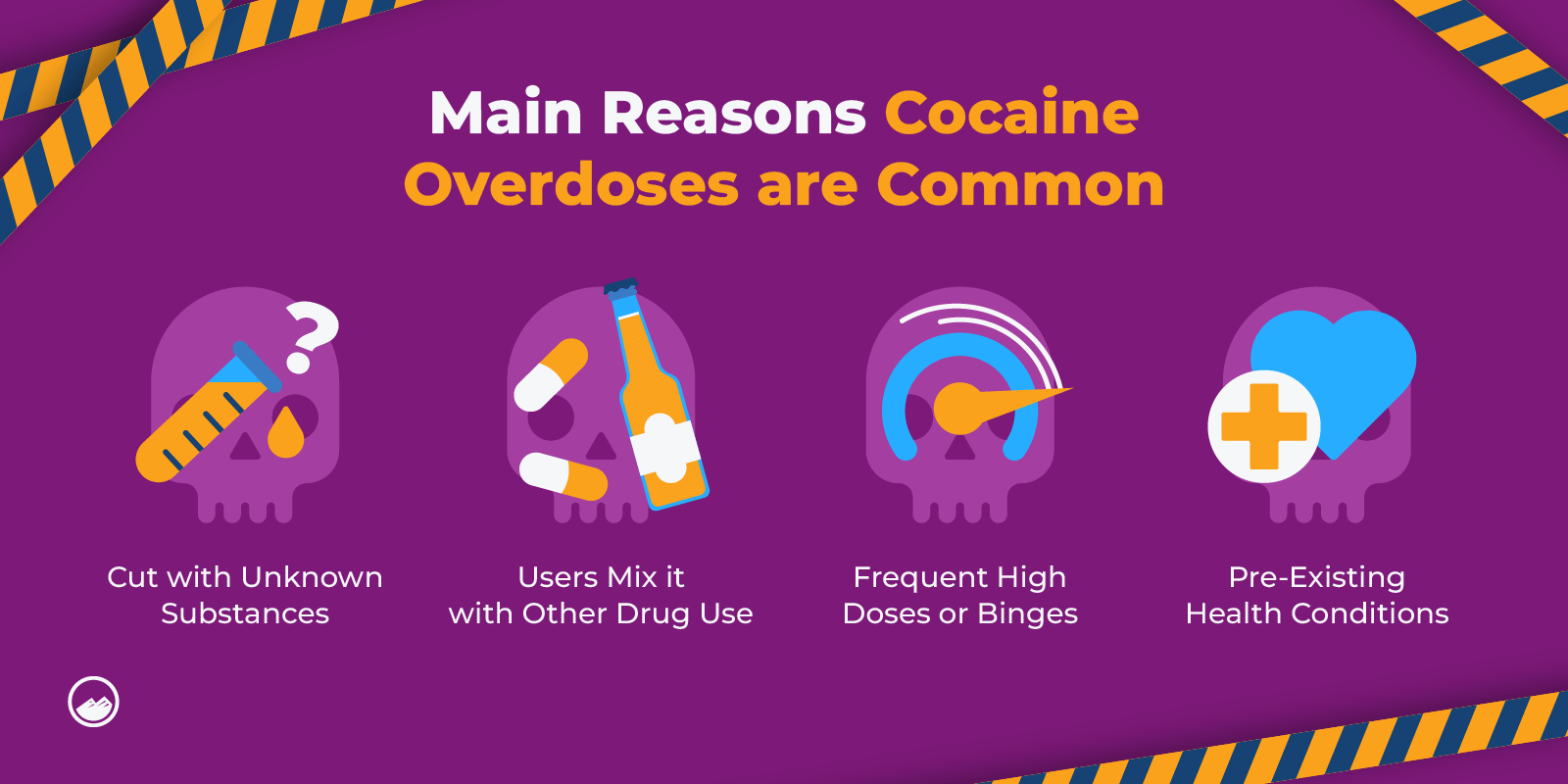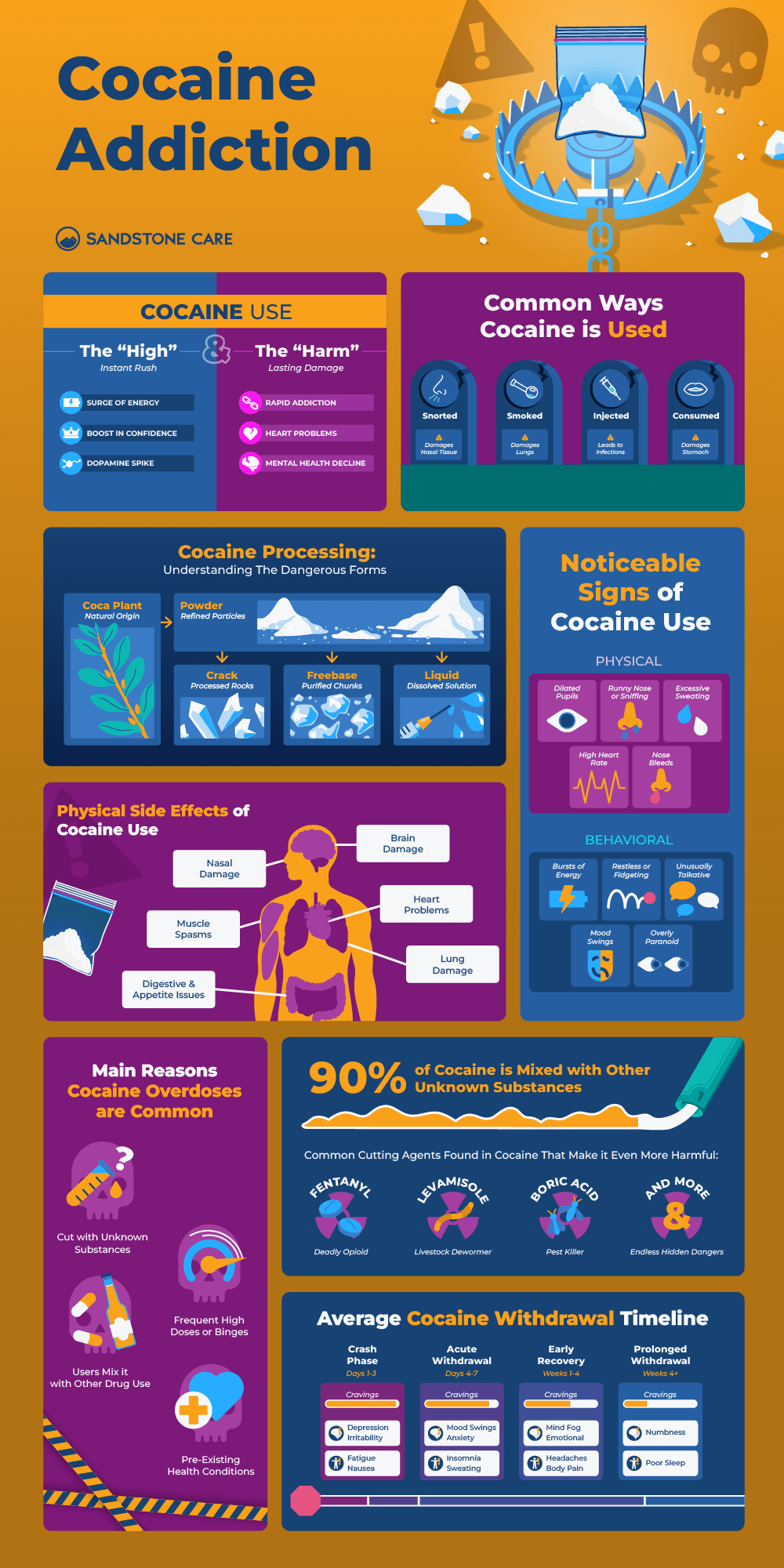What Is Cocaine?
Cocaine is a powerful stimulant drug that affects the central nervous system. It is made from the coca plant, which is native to South America.
Cocaine is most commonly found in the form of a white powder, although it can also be made into small, rock-like crystals called crack.
When people use cocaine, it quickly increases the levels of dopamine in the brain, creating feelings of intense pleasure, energy, and alertness.
However, these effects are short-lived. Cocaine is highly addictive, and people often use it repeatedly in a short time to maintain the high.
Dependency and withdrawal symptoms set in quickly, sometimes only taking a few encounters with the drug to take full effect.
This can result in serious physical and mental health risks, including heart problems, anxiety, paranoia, and, in severe cases, death.
Cocaine is classified as a Schedule 2 drug and has some limited healthcare uses as an anesthetic.
Despite its medical uses, it is often created illegally and without regulation on the street, making it incredibly dangerous and addictive.
What Are Cocaine Street Names?
Cocaine goes by many different names, such as “coke,” “crack,” “crank,” “flake,” and “snow.”
However, street names always evolve as they intend to cloud what is being discussed, so new names are always being added and used.
In 2018, the Drug Enforcement Administration identified over 500 unique terms for cocaine in the United States, ranging from “angel dust” to “yim yom.”
There may also be regionally used street names for cocaine that are unique to specific communities, making tracking illicit cocaine or other illegal drugs challenging.
For example, in New York, cocaine is commonly referred to as “coca,” while in Florida it may be called “sniff.”
What Does Cocaine Look Like?
Cocaine comes in many forms, making it challenging to identify. Some forms of cocaine include a fine white powder, small white rock, or liquid form.
Most commonly, cocaine presents as a fine white powder. This form of cocaine powder is often snorted.
However, there are other forms of cocaine.
Crack cocaine, which looks like a small white rock, is also common, while other processes can cause cocaine to look like small shavings.
Lastly, cocaine powder can also be dissolved in water, creating a liquid solution.
While cocaine is often white, this is also not universally true.
Different methods of illicitly producing cocaine, coupled with the various substances that can be cut into cocaine during its creation, can change the form as well as the color of the drug.
Cocaine can sometimes appear in a light pink, yellow, or even a brownish color.
How Is Cocaine Used?
Because of the various forms of cocaine, it can be used in many different ways. It is possible to snort, inject, and smoke cocaine.
Some forms are also ingested by rubbing them on the gums or are eaten directly.
Cocaine is sometimes mixed with other substances, like cornstarch, to dilute its purity.
This practice is common with street-level cocaine and can increase health risks since users might not be aware of what they are consuming alongside the drug.
Is Cocaine Legal?
Cocaine is a Schedule 2 drug, meaning that it has a high potential for drug abuse. Street-level cocaine is illegal, and the drug has limited use even within a directed medical setting.
Illicit cocaine is always illegal, and both the possession and use of cocaine can lead to legal ramifications.
Types of Cocaine
There are many different forms of cocaine, from powder to crack and freebase cocaine. Exploring each of them is necessary to understand the widespread effects of cocaine.
Cocaine Hydrochloride (Powder Cocaine)
Cocaine hydrochloride is the most common form of cocaine, known as powder cocaine. It appears as a fine, white, crystalline powder.
It is often mixed, or “cut,” with other substances such as lactose, glucose, or baking soda, increasing the volume and potentially enhancing or diminishing its effects.
Users typically snort powder cocaine through the nose, but it can also be dissolved in water and injected directly into the veins.
Crack Cocaine
Crack is a form of cocaine that has been processed to make a rock crystal, also known as “freebase cocaine.”
This crystal is heated to produce vapors, which are smoked. The name “crack” comes from the crackling sound the rocks make when heated.
Crack is more potent and riskier than powder cocaine, leading to rapid and intense highs that are short-lived, making it highly addictive.
Freebase Cocaine
Similar to crack, freebase cocaine is a base form of cocaine that has been processed to remove the hydrochloride additive.
This form is smokable, as it has a lower melting point than powder cocaine.
It is extremely dangerous to produce because the process involves flammable solvents.
There is no “safe” form or amount of cocaine, with even small amounts. There is always an incredibly high risk of substance abuse when interacting with the drug.
Illicit cocaine can often be cut with substances that an individual may not be aware of, which can make them even more dangerous to the user.
Signs of Cocaine Use
Recognizing the signs of cocaine use and cocaine abuse is the first step in overcoming addiction and preventing further devastation from happening in your life or the lives of your loved ones.
What Are the Signs of Cocaine Use?
Some of the most common signs of cocaine use include:
- High blood pressure
- Elevated body temperature
- Sudden bursts of energy
- Dilated pupils
- Runny nose or nosebleeds
- Intense sweating
- Difficulty focusing
- Chest pain
Cocaine’s status as a stimulant means that its use can speed up the connection between a person’s brain and body, leading to sudden and intense bouts of energy.
However, this can be strenuous to a person’s cardiovascular and central nervous systems, leading to additional health risks.
How Long Does Cocaine Last?
The method of ingestion, potency, and other factors, such as what substances were cut into the cocaine, can all affect how long it can persist in a person’s system.
It is common to feel the effects of cocaine within minutes of substance use.
The high of cocaine is also relatively short compared to other illicit substances but can be incredibly intense, lasting about 30 minutes.
However, the “comedown” effects can last for days, depending on the individual and their specific relationship with cocaine use.
How Does Someone Change When Using Cocaine?
Cocaine has many intense and noticeable effects on a person almost immediately after use, from sudden energy bursts, mood swings, impulsive and risky behavior, and more.
Cocaine can also cause someone to suddenly show signs of anxiety, depression, unfounded overconfidence in abilities or capabilities, compromised decision-making skills, frustration, anger, euphoria, and restlessness.
What Are Cocaine Eyes?
Cocaine eyes refer to a combination of symptoms of cocaine use that are visible in the eyes with dilated pupils and intense redness.
Cocaine stimulates the nervous system, causing the muscles in the eyes that control pupil size to relax, leading to larger-than-normal pupils, which makes them more sensitive to light.
In addition to pupil dilation, cocaine use can cause red or bloodshot eyes due to increased blood pressure and irritation of the eyes.
Some people may also experience blurred vision or sensitivity to bright lights as a result of the drug’s effects on the nervous system.
These eye-related symptoms are temporary but can be a visible sign of cocaine use, especially when combined with other behaviors such as jitteriness or hyperactivity.
What Is Cocaine Nose?
Cocaine nose or “coke nose” is a common effect of cocaine use, particularly in those who snort cocaine. It describes the destruction and deterioration of nasal cavities and tissues.
Cocaine is an anesthetic, meaning that it constricts blood vessels and, with repeated use, can cause the nose to become incredibly damaged due to cocaine use.
This lack of nutrients going to the nose can cause tissue in the nose to deteriorate.
Accompanied with nosebleeds and runny nose, the nose can become incredibly damaged.
Cocaine Side Effects
While the immediate effects of cocaine use can be quick, many lasting side effects of cocaine use can damage the physical and mental health of cocaine users.
What Does Cocaine Do to Your Body?
Cocaine has many effects on the body, including dilated pupils, high blood pressure, increased heart rate, elevated body temperature, and narrowed blood vessels.
Depending on the method of use, an individual may also experience intense damage to their nose.
Injecting cocaine can also cause track marks, which can become infected, especially if sharing needles with others.
How Does Cocaine Affect the Brain?
Cocaine use forces the release of dopamine or the “feel good” chemical in the brain. Some of the negative effects of cocaine on the brain include:
- Hectic and disorganized thoughts
- Paranoia
- Anxiety
- Depression
- Psychosis
- Hallucinations
Normally, dopamine is released during pleasurable activities and then recycled back into the cells that produced it.
However, cocaine blocks this recycling process, causing dopamine to build up in the brain.
This flood of dopamine creates intense feelings of euphoria, energy, and alertness.
These effects are short-lived, which often leads people to use the drug repeatedly in a short period.
Over time, this can cause the brain to adapt by producing less dopamine naturally, making it harder for a person to feel pleasure without the drug.
Cocaine use also affects other areas of the brain, leading to problems with decision-making, impulse control, and emotional regulation.
What Are the Long-Term Effects of Cocaine?
Some of the most prevalent long-term effects of cocaine include:
- Aches and pains
- Persistent damage to the nose, such as nosebleeds, runny nose, and lack of smell
- Kidney damage
- Liver damage
- Damage to lungs, especially if smoked
- Track marks, HIV/AIDS if sharing needles, and hepatitis
- Increased chance of seizures
- Heart disease
- Increased chances of heart attack
- Sudden death
Cocaine’s impact on the brain is equally damaging over time.
Regular use can result in memory problems, difficulty concentrating, and impaired decision-making.
It also increases the likelihood of developing mental health issues, such as anxiety, depression, paranoia, and, in some cases, hallucinations.
Over time, the brain’s reward system becomes less responsive, making it harder for users to feel pleasure without the drug, fueling the cycle of addiction.
Cocaine Addiction
Is Cocaine Addictive?
Yes, cocaine is extremely addictive.
It disrupts the brain’s reward system by triggering a surge of dopamine, the chemical that makes us feel pleasure and satisfaction.
This creates a brief but intense sense of euphoria, which fades quickly, often pushing users to take more of the drug to recapture that feeling.
Over time, the brain becomes less able to produce dopamine on its own, making it harder to experience joy without using cocaine.
This leads to a strong psychological dependence, where a person feels an overwhelming urge to keep using cocaine, even if it’s harming their health or well-being.
The compulsion to continue using despite negative consequences is a hallmark of cocaine addiction, making it very difficult to quit without help.
What Are the Signs of Cocaine Addiction?
There can be many various behavioral, physical, cognitive, and psychological signs of a cocaine addiction.
Some behavioral signs of cocaine addiction include:
- Drastic changes in energy levels
- Increase in lying or secretive behavior, such as locking doors or disappearing without telling anyone.
- Engaging in increasingly risky behaviors
- Stealing
The physical effects of cocaine addiction include:
- Dilated pupils or “cocaine eyes”
- Damaged nasal cavities and “coke nose”
- Elevated heart rate and sweating
- Track marks at injection sites
- Strained cardiovascular system and increase in risk of heart attack
- Insomnia or inconsistent sleep routine
The cognitive signs of cocaine addiction include:
- Compromised decision-making skills
- Overconfidence in abilities
- Psychosis
- Mental and emotional restlessness
Common psychological signs of cocaine addiction include:
- Being quick to anger or persistent irritation or frustration
- Depression
- Anxiety or paranoia
- Intense and drastic mood swings
Being cognizant of these signs can empower family members and loved ones to help identify addiction and pursue professional care like the programs available at Sandstone Care.
When Is It Time to Seek Help for a Cocaine Addiction?
It’s time to seek help for a cocaine addiction when the drug starts to interfere with daily life, relationships, or your health.
If you find yourself using cocaine more frequently or in larger amounts than you intended, or if you experience strong cravings or a loss of control over your use, these are clear signs of addiction.
Other indicators include neglecting responsibilities at work, school, or home, continuing to use cocaine despite knowing the harm it’s causing, or experiencing withdrawal symptoms like anxiety, fatigue, or depression when not using.
If cocaine use is causing problems in your personal life, finances, or physical or mental health, it’s important to seek professional help. The earlier treatment begins, the better the chances of recovery.
Cocaine Detox
Detoxing from cocaine can be exceptionally difficult. Professional treatment and care are often necessary to effectively navigate the challenges of cocaine detox.
How Do You Detox from Cocaine?
Detoxing from cocaine can be challenging and uncomfortable, with dedicated detox programs being necessary.
Detoxing from cocaine involves not just the cessation of cocaine but also planning for the challenging withdrawal symptoms ahead. For some, medication is necessary to help address these challenges, along with exploring potential treatment options to transition to further care.
Distancing oneself from stresses and opportunities to reengage with cocaine and the lifestyles that enabled such use is also important.
How Long Does It Take to Detox From Cocaine?
The length of each detox program will vary from person to person. In general, it will take a few days for the body to expel the traces of the substance from a person’s body.
However, that does not mean that an individual will be free of the effects of cocaine. It can continue to have lasting effects on a person’s physical and mental health. Coupled with persistent withdrawal symptoms, the detox program will vary from person to person.
What Are Cocaine Withdrawal Symptoms?
Cocaine withdrawal symptoms include:
- Depression, anxiety, and paranoia
- Aches and pains
- Nausea
- Vomiting
- Insomnia
- Fatigue
- Nightmares
- Sweating and shaking
- Irritation or persistent anger
- Mood swings
- Intense cravings
Cocaine withdrawal symptoms occur when someone who has been using the drug regularly stops or significantly reduces their use.
Unlike some other substances, cocaine withdrawal doesn’t typically involve severe physical symptoms, but the psychological effects can be intense.
These symptoms can make it difficult to stop using cocaine without support, as the cravings and emotional distress often lead to relapse.
Do You Need Medical Detox for Cocaine?
It is possible to navigate cocaine withdrawal without medication. Likewise, no medication can “fix” withdrawal for a person or completely mitigate its effects.
However, some medications can be instrumental in handling specific withdrawal symptoms like depression, aches, and other effects of drug use.
Using medication to address specific challenges can help a person better navigate withdrawal and transition to further levels of care.
How Long Does Cocaine Stay in Your System?
Signs of cocaine use can be found in saliva within two days of use, whereas testing a person’s hair can yield positive results for up to 90 days.
Cocaine can remain in a person’s system for a long time following their last use. Exactly how long can vary depending on the way it is tested.
How Long Does Cocaine Stay in Urine?
Cocaine can typically be detected in urine for up to four days after use.
However, this time frame can vary depending on several factors, such as the amount of cocaine used, frequency of use, and individual metabolism.
For heavy or chronic users, cocaine may be detectable in urine for up to a week or longer.
How Long Does Cocaine Stay in Your Blood?
Cocaine can be detected in the blood for up to two days after use.
Cocaine is rapidly metabolized in the body, and while the drug itself leaves the bloodstream relatively quickly, its byproducts can stay detectable for a longer period.
Cocaine Overdose
Can You Overdose on Cocaine?
Yes. High doses of cocaine or using it more often can result in a cocaine overdose.
Combining cocaine with other substances like alcohol, fentanyl, or heroin can also greatly increase the chances of an overdose. This mixing of uppers and downers is also referred to as “speedball.”
Many illicit drugs may be cut with additional substances that an individual may not be aware of, making illicit cocaine use incredibly dangerous.
What Are the Signs of Cocaine Overdose?
Signs of a cocaine overdose include:
- Sweating
- Vomiting
- Irregular heartbeat
- Difficulty breathing or rapid breathing patterns
- Tightness in chest
- Hallucinations
- Tremors
- Seizures
- Highly elevated body temperature
Identifying the signs of a cocaine overdose quickly is necessary to provide the most efficient and necessary care to navigate this time and can potentially prevent the death of a loved one experiencing an overdose.
What Do You Do If Someone Overdoses on Cocaine?
If someone overdoses on cocaine, it’s crucial to act quickly. Cocaine overdose can be life-threatening, so call emergency services immediately.
While waiting for help to arrive, try to keep the person calm and in a comfortable position, as panic and movement can worsen the effects of the overdose.
If they are conscious, encourage them to breathe slowly and deeply to help reduce their heart rate.
If the person is unconscious, make sure they are lying on their side to prevent choking, especially if they vomit.
Keep an eye on their breathing, and if it stops or becomes irregular, be prepared to administer CPR if you are trained to do so.
Cocaine overdose can cause severe complications like seizures, heart attacks, or strokes.
Medical professionals will administer treatments like oxygen, medications to control seizures or heart problems, and other life-saving interventions.
Avoid trying to handle the situation on your own. Cocaine overdoses are serious, and they require immediate professional care to prevent serious harm or death.
Cocaine Addiction Treatment
Finding professional treatment for cocaine users is paramount for an effective approach to sobriety. However, the journey to a sober, cocaine-free future is very personal and will look different for each person.
What Are the Different Treatments for Cocaine?
There are many different treatment programs available to address cocaine addiction. An individual may also explore multiple treatment options in their journey to a sober future.
Professional detox programs, residential treatment options, and even sober housing and transitional living spaces are all common throughout treatment for cocaine addiction.
Many of these programs also utilize a combination of therapeutic practices, from medication-assisted treatment (MAT) to cognitive-behavioral therapy (CBT), dialectical behavioral therapy, and various experiential therapies. Each treatment facility will have unique options to explore. Contacting local treatment facilities is the best way to understand the various options available.
What Is the Best Treatment for Cocaine Addiction?
The best treatment for cocaine addiction often begins with detox, which is the process of allowing the body to clear itself of cocaine and its harmful ingredients.
During detox, medical supervision is typically recommended to manage withdrawal symptoms and ensure safety, as cravings and psychological distress can be intense.
After detox, treatment usually involves a combination of behavioral therapies, such as cognitive-behavioral therapy (CBT), which helps individuals identify and change harmful thought patterns and behaviors related to cocaine use.


